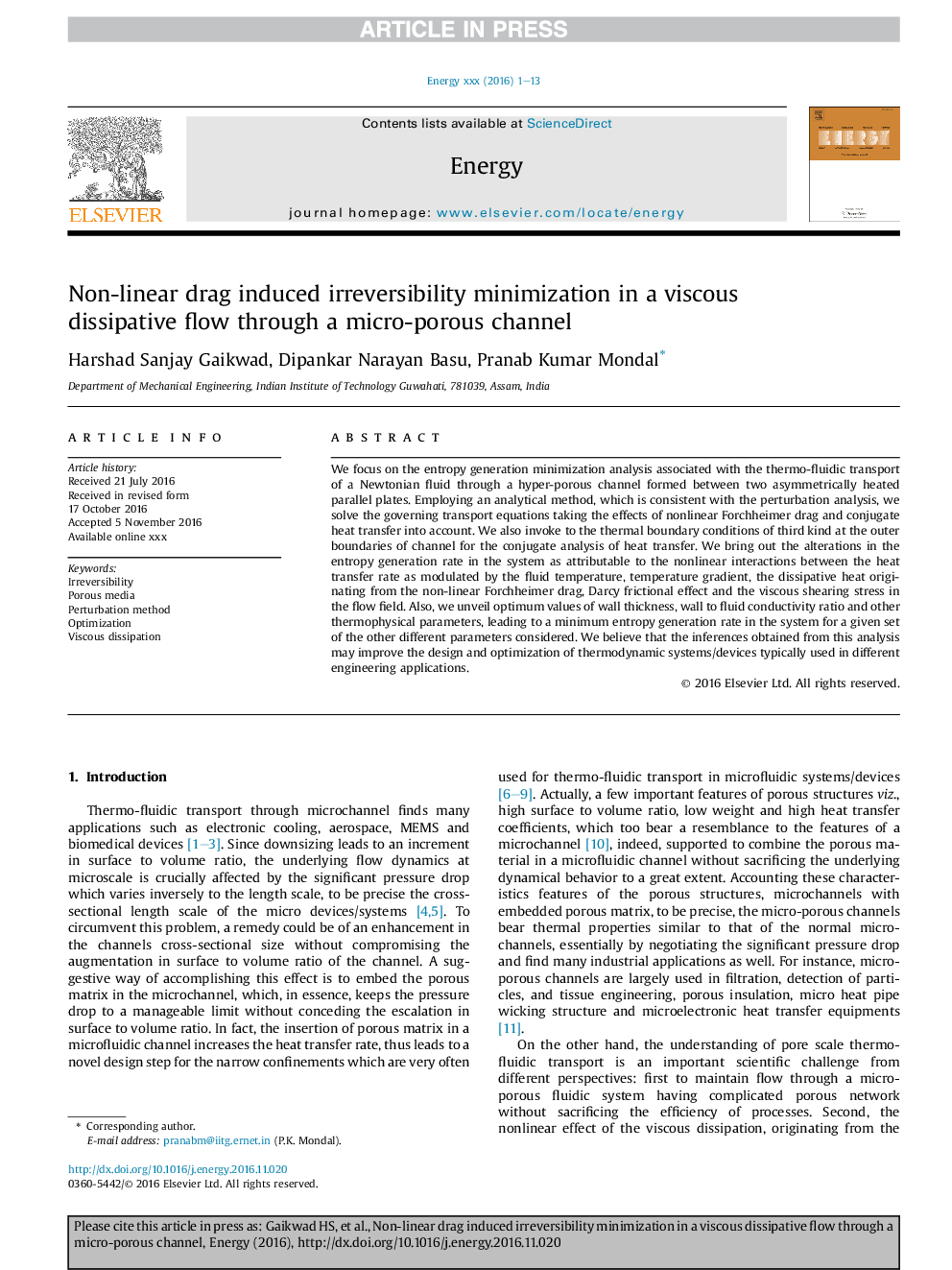| کد مقاله | کد نشریه | سال انتشار | مقاله انگلیسی | نسخه تمام متن |
|---|---|---|---|---|
| 5476908 | 1521432 | 2017 | 13 صفحه PDF | دانلود رایگان |
عنوان انگلیسی مقاله ISI
Non-linear drag induced irreversibility minimization in a viscous dissipative flow through a micro-porous channel
ترجمه فارسی عنوان
کشش غیر خطی موجب کاهش غیر قابل برگشت شدن در یک جریان نفوذی چسبندگی از طریق یک کانال میکرو متخلخل می شود
دانلود مقاله + سفارش ترجمه
دانلود مقاله ISI انگلیسی
رایگان برای ایرانیان
کلمات کلیدی
برگشت پذیری، رسانه های متخلخل، روش اختلال، بهینه سازی، تجمع چسبنده،
ترجمه چکیده
ما بر روی تحلیل مینیمم نسل آنتروپی مرتبط با انتقال حرارتی سیال نیوتونی از طریق یک کانال بیش از حد متخلخل که بین دو ورق موازی نامتقارن گرم ایجاد شده است تمرکز می کنیم. با استفاده از یک روش تحلیلی، که با تجزیه و تحلیل تحرک سازگار است، ما معادلات حمل و نقل حاکم را در نظر می گیریم که تاثیرات غیرخطی فرشهایمر و انتقال گرما را با هم ترکیب می کنند. ما همچنین به شرایط مرزی حرارتی نوع سوم در مرزهای بیرونی کانال برای تحلیلی از انتقال گرما متصل می شویم. ما تغییرات در نرخ تولید انتروپی در سیستم را به عنوان مربوط به تعامل غیر خطی بین نرخ انتقال حرارت به عنوان تعدیل شده توسط دمای مایع، گرادیان درجه حرارت، گرمای تابشی ناشی از کشیدن فرشهایمر غیر خطی، اثر اصطکاک دارسی و تنش برشی چسبنده در میدان جریان. همچنین ما مقادیر بهینه ضخامت دیواره، نسبت رسانایی دیواره به مایع و دیگر پارامترهای گرماسفیسی را پیش بینی می کنیم که منجر به حداقل نرخ تولید آنتروپی در سیستم برای یک مجموعه داده شده از پارامترهای مختلف دیگر مورد نظر می شود. ما بر این باوریم که نتیجه گیری های حاصل از این تجزیه و تحلیل ممکن است طراحی و بهینه سازی سیستم های ترمودینامیکی / دستگاه هایی که معمولا در برنامه های مهندسی مختلف استفاده می شود را بهبود بخشد.
موضوعات مرتبط
مهندسی و علوم پایه
مهندسی انرژی
انرژی (عمومی)
چکیده انگلیسی
We focus on the entropy generation minimization analysis associated with the thermo-fluidic transport of a Newtonian fluid through a hyper-porous channel formed between two asymmetrically heated parallel plates. Employing an analytical method, which is consistent with the perturbation analysis, we solve the governing transport equations taking the effects of nonlinear Forchheimer drag and conjugate heat transfer into account. We also invoke to the thermal boundary conditions of third kind at the outer boundaries of channel for the conjugate analysis of heat transfer. We bring out the alterations in the entropy generation rate in the system as attributable to the nonlinear interactions between the heat transfer rate as modulated by the fluid temperature, temperature gradient, the dissipative heat originating from the non-linear Forchheimer drag, Darcy frictional effect and the viscous shearing stress in the flow field. Also, we unveil optimum values of wall thickness, wall to fluid conductivity ratio and other thermophysical parameters, leading to a minimum entropy generation rate in the system for a given set of the other different parameters considered. We believe that the inferences obtained from this analysis may improve the design and optimization of thermodynamic systems/devices typically used in different engineering applications.
ناشر
Database: Elsevier - ScienceDirect (ساینس دایرکت)
Journal: Energy - Volume 119, 15 January 2017, Pages 588-600
Journal: Energy - Volume 119, 15 January 2017, Pages 588-600
نویسندگان
Harshad Sanjay Gaikwad, Dipankar Narayan Basu, Pranab Kumar Mondal,
